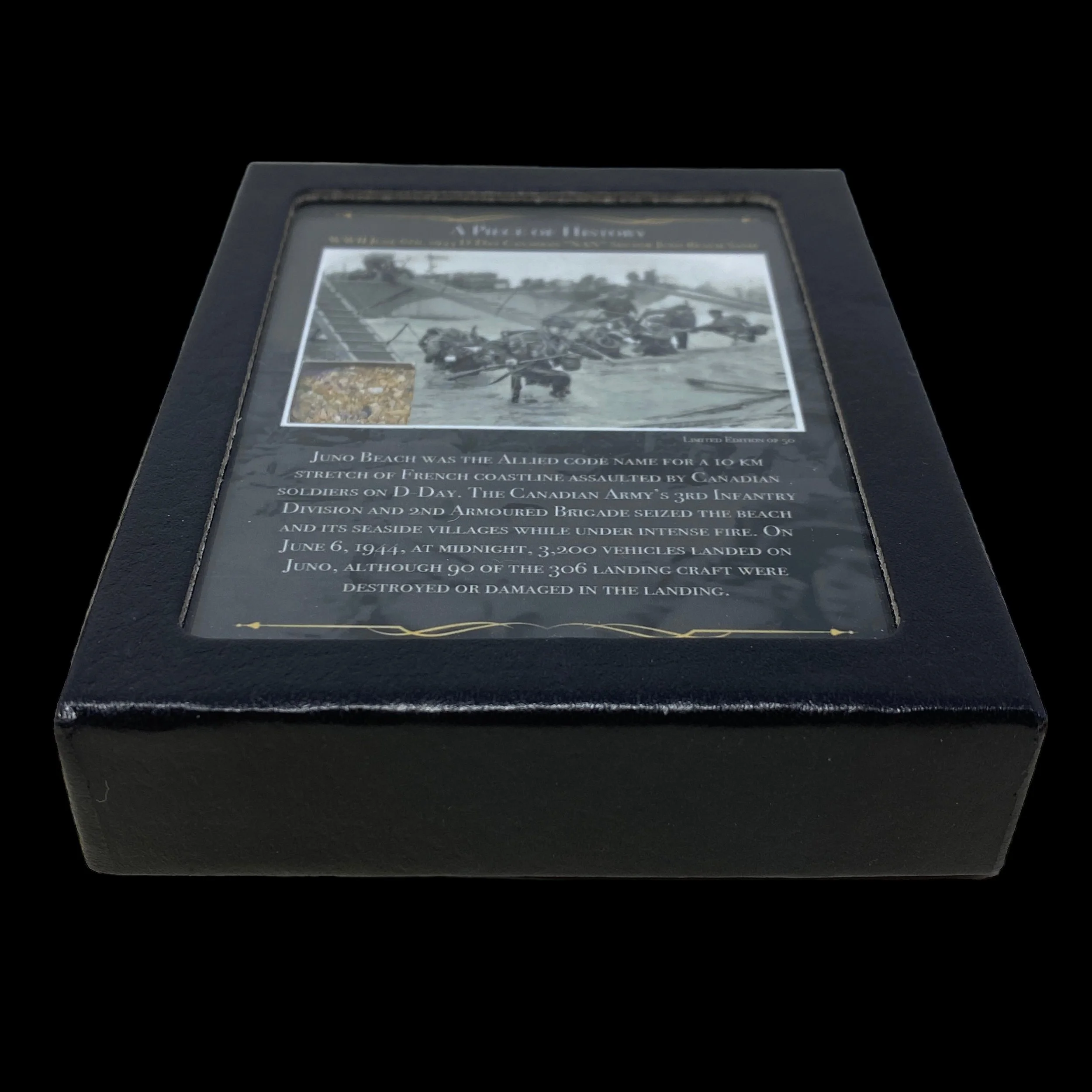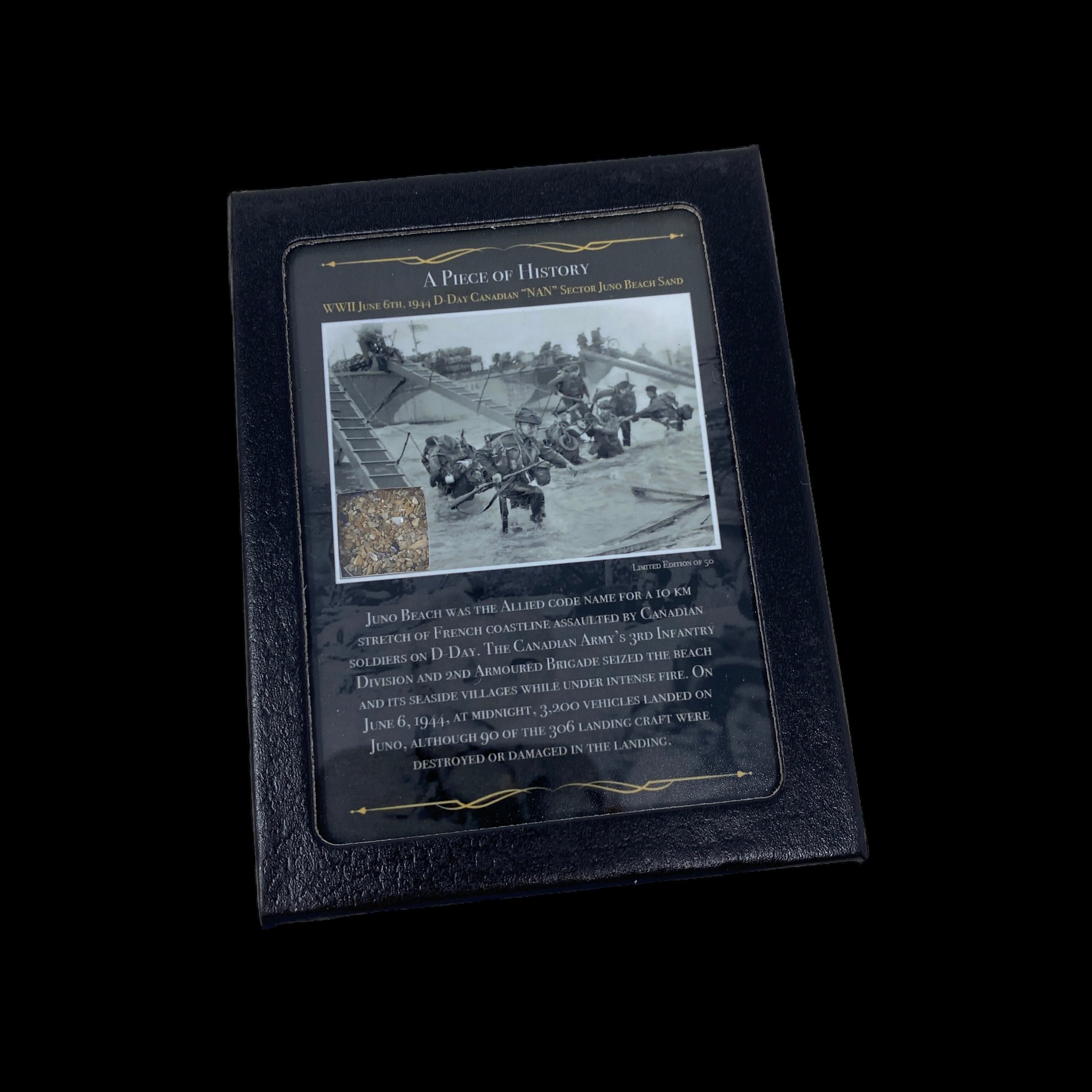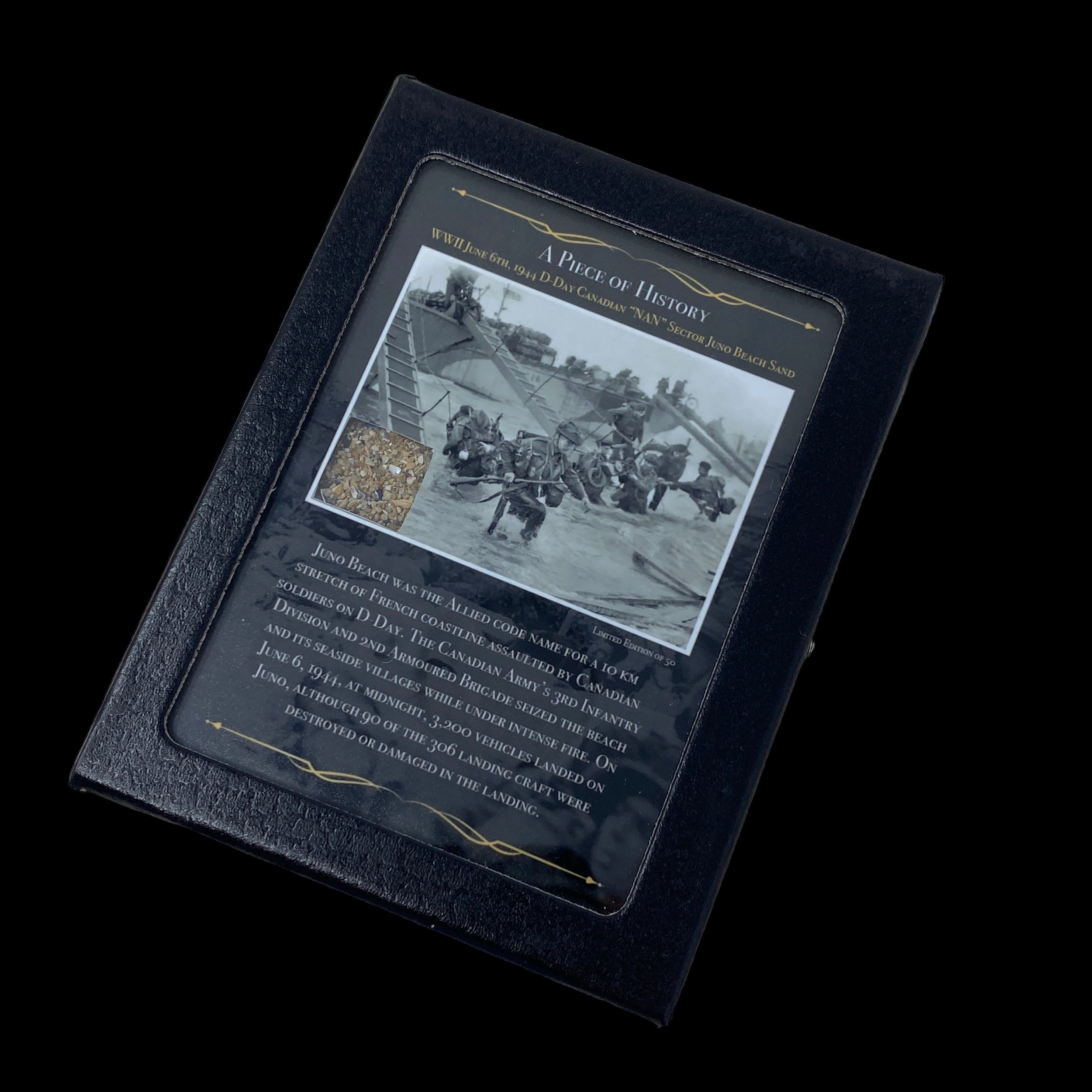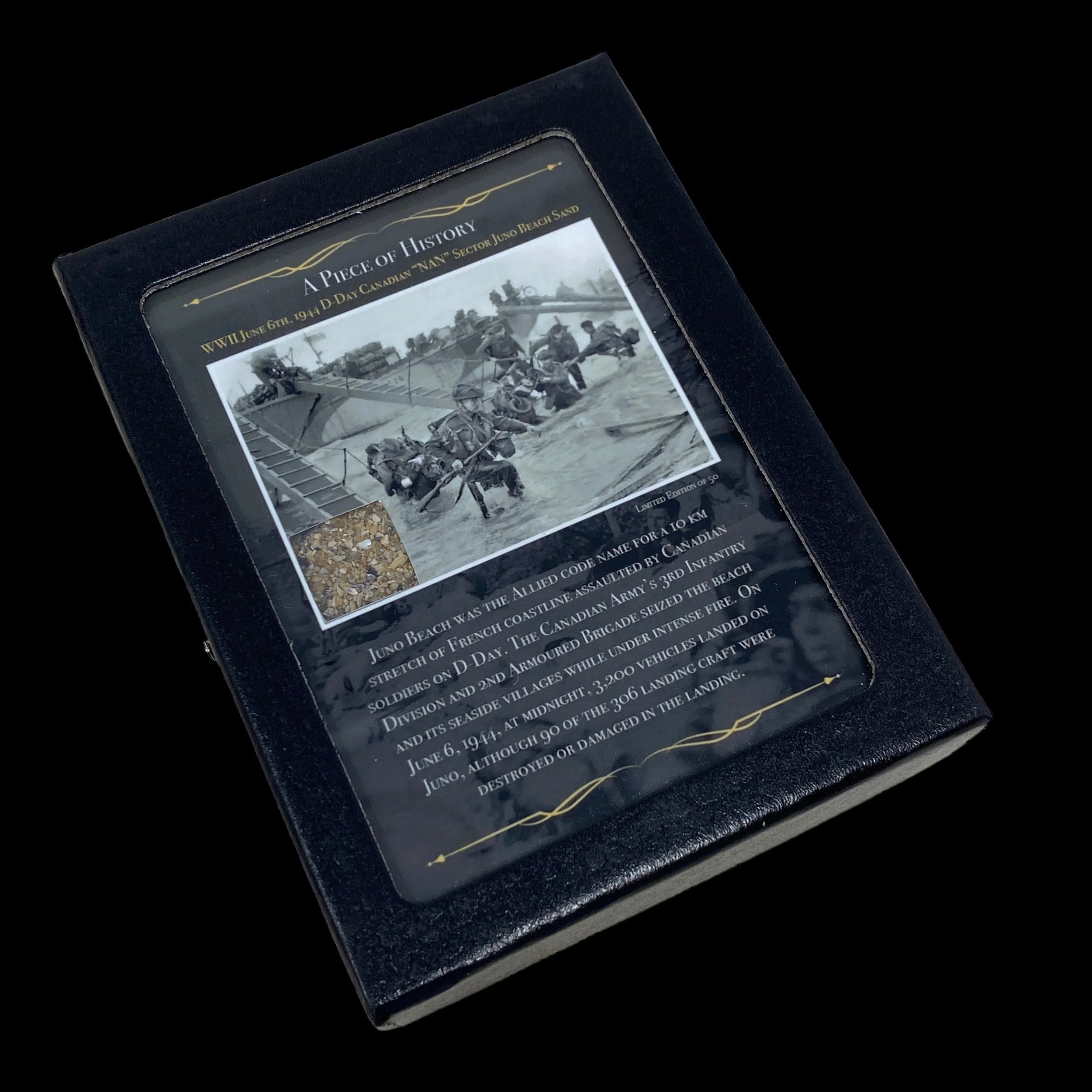RARE! WWII June 6th, 1944 D-Day Juno Beach "EASY RED" Sector Sand with Display Case (C.O.A. Included)
























RARE! WWII June 6th, 1944 D-Day Juno Beach "EASY RED" Sector Sand with Display Case (C.O.A. Included)
Comes with a hand-signed C.O.A. and a full historical research write-up.
*Limited Edition of 50*
Own your piece of history today!
Due to an incredibly high demand for display case options, we are proud to offer one of our LIMITED EDITION series of HISTORIC DISPLAY CASE EXCLUSIVES. This incredible “Piece of History“ is professionally encased in a glass display case with plush padding and a tightly sealed display case. Each display features a historical photograph and a short description that corresponds to the artifact displayed. This display case measures a perfect 4.25 inches tall x 3.25 inches wide.
This series is a limited edition of 50 pieces, meaning that each “Piece of History” display is unique. The D-Day Juno Beach sand you receive may vary slightly from the display shown.
Monday, June 5th, 1944: near Southampton, England, the men of the 3rd Canadian Infantry Division and the 2nd Canadian Armoured Brigade had already boarded the ships. LCA slung from the davits, the ships sailed off at dawn, followed by the large landing crafts for infantry and tanks. They passed Portsmouth around 0900. On the way, subaltern officers and later troops were briefed. They broke open the seals and took out the maps where the actual targets were shown. This was no exercise…
Operation Overlord was only one step of a global strategic plan for the complete defeat of Nazi Germany. The Normandy landing was designed to establish a bridgehead from which two armies, the First US Army on the west flank and the Second British Army to the east could be supplied by sea. With the bridgehead firmly secured, the armies were to move on to liberate France and the neighbouring countries. Germany, attacked on three separate fronts, in Northwest Europe, in Russia, and in the Mediterranean, would soon be exhausted and defeated.
On June 6th, 1944, the 3rd Canadian Infantry Division and the 2nd Armoured Brigade were tasked with establishing a bridgehead on the beach codenamed “Juno”. This was an eight-kilometre long stretch of beach bordering Saint-Aubin, Bernières, Courseulles-sur-Mer and Graye-sur-Mer. Assault troops were then to move towards the Carpiquet airfield, 18 kilometres inland. The 3rd Infantry Division, under Major-General R.F.L. Keller, was under command of the Second British Army. It was flanked on the left by the 3rd British Infantry Division that was to land on Sword beach (Lion-sur-Mer, Langrune-sur-Mer). To the right, the 50th British Division had as its target “Gold Beach” (La Rivière, Le Hamel, and Arromanches).
Full History of Juno Beach on D-Day:
Juno or Juno Beach was one of five beaches of the Allied invasion of German-occupied France in the Normandy landings on 6 June 1944 during the Second World War. The beach spanned from Courseulles, a village just east of the British beach Gold, to Saint-Aubin-sur-Mer, and just west of the British beach Sword. Taking Juno was the responsibility of the First Canadian Army, with sea transport, mine sweeping, and a naval bombardment force provided by the Royal Canadian Navy and the British Royal Navy as well as elements from the Free French, Norwegian, and other Allied navies. The objectives of the 3rd Canadian Infantry Division on D-Day were to cut the Caen-Bayeux road, seize the Carpiquet airport west of Caen, and form a link between the two British beaches on either flank.
The beach was defended by two battalions of the German 716th Infantry Division, with elements of the 21st Panzer Division held in reserve near Caen.
The invasion plan called for two brigades of the 3rd Canadian Division to land on two beach sectors—Mike and Nan—focusing on Courseulles, Bernières and Saint-Aubin.[a] It was hoped that the preliminary naval and air bombardments would soften up the beach defences and destroy coastal strong points. Close support on the beaches was to be provided by amphibious tanks of the 2nd Canadian Armoured Brigade and specialized armoured vehicles of the 79th Armoured Division of the United Kingdom. Once the landing zones were secured, the plan called for the 9th Canadian Infantry Brigade to land reserve battalions and deploy inland, the Royal Marine commandos to establish contact with the British 3rd Infantry Division on Sword and the 7th Canadian Infantry Brigade to link up with the British 50th Infantry Division on Gold. The 3rd Canadian Division's D-Day objectives were to capture Carpiquet Airfield and reach the Caen–Bayeux railway line by nightfall.
The landings encountered heavy resistance from the German 716th Division; the preliminary bombardment proved less effective than had been hoped, and rough weather forced the first wave to be delayed until 07:35. Several assault companies—notably those of the Royal Winnipeg Rifles and The Queen's Own Rifles of Canada—took heavy casualties in the opening minutes of the first wave. Strength of numbers, coordinated fire support from artillery, and armoured squadrons cleared most of the coastal defences within two hours of landing. The reserves of the 7th and 8th brigades began deploying at 08:30 (along with the Royal Marines), while the 9th Brigade began its deployment at 11:40.
The subsequent push inland towards Carpiquet and the Caen–Bayeux railway line achieved mixed results. The sheer numbers of men and vehicles on the beaches created lengthy delays between the landing of the 9th Brigade and the beginning of substantive attacks to the south. The 7th Brigade encountered heavy initial opposition before pushing south and making contact with the British 50th Division at Creully. The 8th Brigade encountered heavy resistance from a battalion of the 716th at Tailleville, while the 9th Brigade deployed towards Carpiquet early in the evening. Resistance in Saint-Aubin prevented the Royal Marines from establishing contact with the British 3rd Division on Sword. By the time all operations on the Anglo-Canadian front were ordered to halt at 21:00, The Queen's Own Rifles of Canada had reached its D-Day objective and the 3rd Canadian Infantry Division had succeeded in pushing farther inland than any other landing force on D-Day.